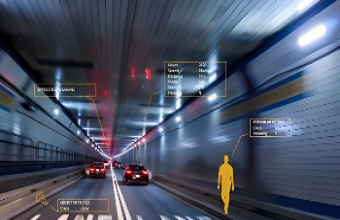Revolutionizing Tunnel Safety: AI-Powered Incident Detection Enhances Road Security
Camera-based incident detection has become an essential technology for tunnel operators in ensuring road safety and facilitating rapid response. The introduction of thermal cameras marked a significant milestone in achieving 24/7 automatic incident detection, but now, systems integrated with artificial intelligence (AI) are poised to take tunnel safety to new heights. AI technology is already elevating incident detection to unprecedented levels of performance.
In February 2023, the European Commission released preliminary figures on road fatalities for 2022, revealing a 3% increase compared to 2021 as traffic levels rebounded after the pandemic. Despite being 10% lower than 2019 figures, the EU still strives to halve the number of road deaths by 2030.
While incidents in tunnels are typically less frequent than on open roads, their severity is often higher. To address this, a 2004 European directive prompted the deployment of incident detection systems in tunnels, leading to continuous advancements in technology. With the evolution of video analytics-based systems, tunnels have become safer. First-response teams can now be dispatched within minutes or even seconds of detecting an incident or irregularity, such as a fallen object, pedestrian, or slowing vehicle.
Thermal cameras have emerged as a well-established technology, proving critical in ensuring accurate detection throughout tunnel infrastructures. Their effectiveness is particularly evident at tunnel entrances and exits, where shadows and direct sunlight can hinder visible-light cameras and disrupt traffic detection. By detecting heat rather than light, thermal cameras remain unaffected by these phenomena, enabling round-the-clock traffic detection in all weather conditions.
One of the significant advantages of thermal imaging cameras in tunnel safety is their ability to see through various types of smoke, making them invaluable for emergency response teams navigating smoke-filled tunnels and for incident detection systems to promptly identify anomalies.
Moreover, thermal cameras are immune to the challenges posed by headlights, which often pose difficulties for conventional closed-circuit television (CCTV) systems. Headlights can result in false or missed alarms, rendering accurate observation of nighttime highway traffic virtually impossible. In contrast, thermal cameras can clearly detect the heat signatures of vehicles from miles away. They are also highly effective in detecting fires in tunnels at an early stage, providing traffic operators with the means to promptly close the tunnel and initiate fire suppression measures.
While both visual and thermal cameras offer their respective advantages, combining these detection technologies into a single system allows operators to benefit from the best of both worlds. Teledyne FLIR's ITS-Series Dual AID camera exemplifies such integration.
The profound impact of AI technology on incident detection cannot be overlooked. Over the years, increased computing speeds, lower costs, and the exponential growth of data have significantly improved AI's efficiency. Data-based systems, empowered by AI, have replaced conventional rule-based detection methods. These advanced systems can be trained on extensive datasets of images, enabling them to identify and classify objects within an image and make informed decisions when encountering new and unfamiliar situations.
Unlike previous generations of traffic detectors that relied on subtle color differences at the pixel level, today's AI-powered detectors analyze the entire camera image, allowing for intelligent decision-making. AI systems excel in handling complex traffic scenarios and making accurate predictions.
AI-powered systems offer several advantages over non-AI detectors. Firstly, they achieve higher detection accuracy, mitigating the frustration caused by false alarms and reducing erroneous responses from emergency teams. Additionally, AI-based detectors are adept at distinguishing between different vehicle classes, enabling precise classification of cars, vans, and trucks. Furthermore, AI systems can be trained to recognize customized classes, simply by feeding them new data. Their exceptional performance remains consistently high, even when deployed in less ideal camera positions.
AI detectors also excel in predicting vehicle trajectories. Leveraging vehicle parameters such as speed and direction, they can accurately.












